One of the most beautiful elements about the genus haworthia, is how incredibly varied the species are. Some of the most commonly known species have what are known as ‘windows’, where light travels directly into the leaves. These windows are characteristic of several species; however, there are others that are identified by ridges and tubercles.
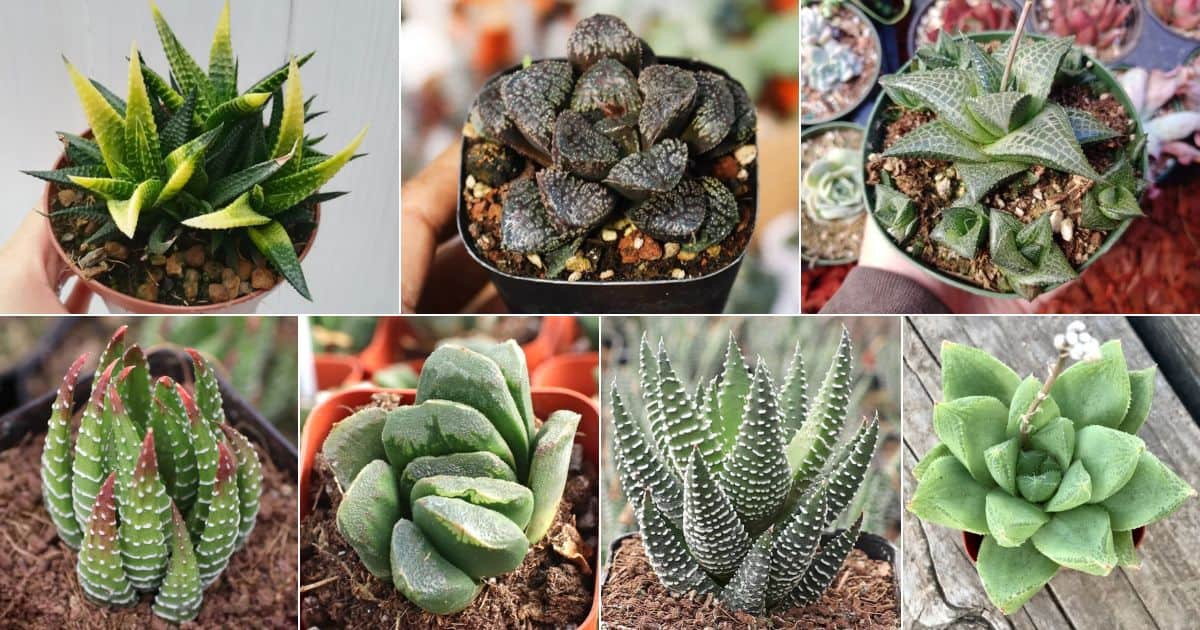
In this informative post, you’ll find a wide variety of haworthia species, including some that are so rare you might have to purchase them outside of your country!
Jump to:
- 1. Haworthia cooperi
- 2. Haworthia attenuata, Zebra Plant
- 3. Blue Diamond
- 4. Zebra Haworthia
- 5. Haworthia cuspidata
- 6. Pearl Plant
- 7. Moon Shadow
- 8. Pink Mutica
- 9. Haworthia cymbiformis
- 10. Haworthia coarctata
- 11. Haworthia tortuosa, Variegated
- 12. Emerald Cloud*
- 13. Fairies Washboard
- 14. Haworthia limifolia, Variegated
- 15. Haworthia Obtusa ssp.
- 16. Love Heart*
- 17. Black Beauty
- 18. Haworthia truncata var. maughanii
- 19. Red Stone
- 20. Haworthia cooperi var. venusta
- 21. Haworthia tessellata
- 22. Mordor
- 23. Iron Ball
1. Haworthia cooperi
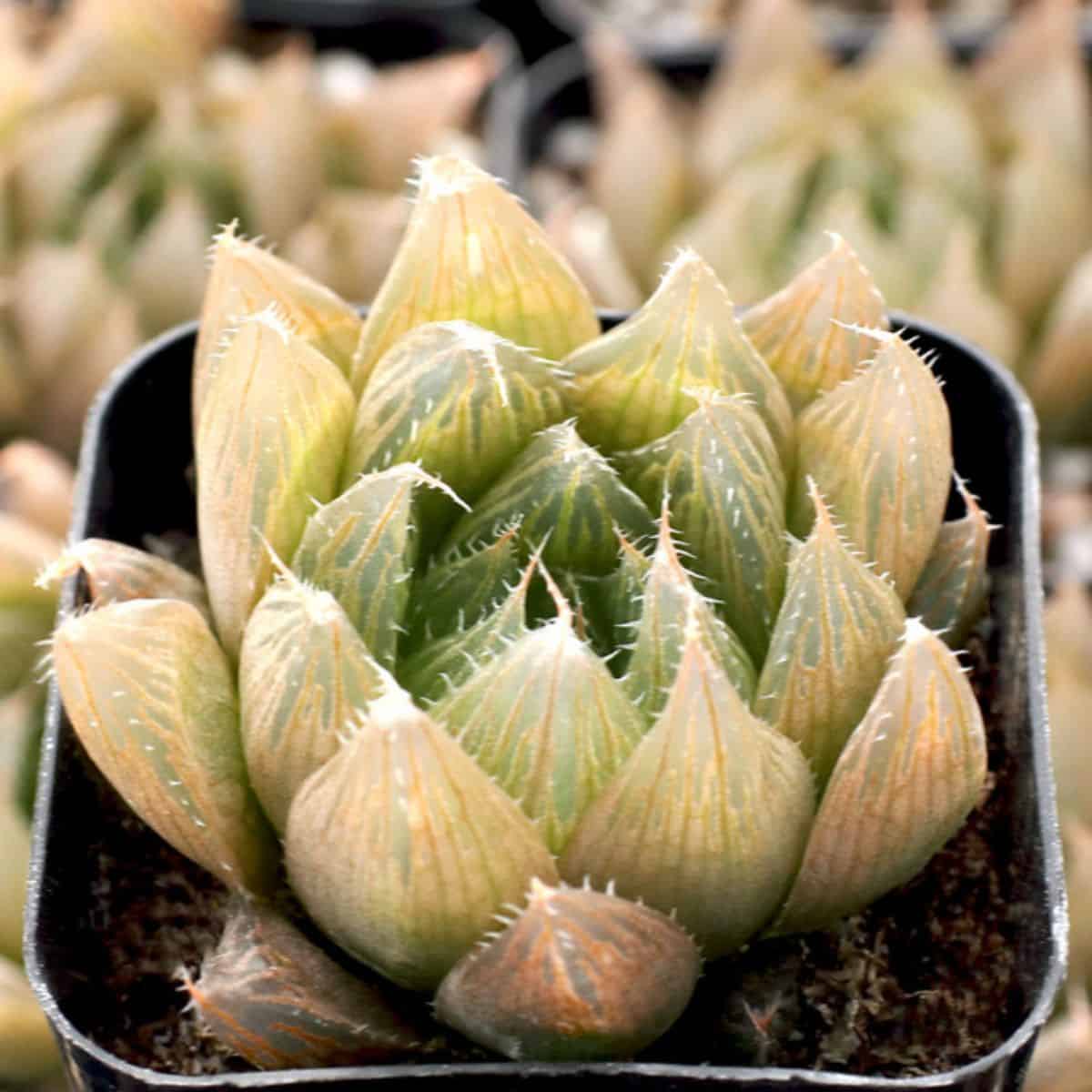
Buy it from:
| Maximum Height: | 5 inches |
| Maximum Width: | 4 inches |
| Watering Needs: | Once per week |
| Soil Needs: | Loamy well-draining soil |
| Light Needs: | Indirect sun, only 4 hours of bright sunlight or burns will occur |
| Hardiness Zone(s): | Zone 9 and up |
| Bloom Color: | White |
| Bloom Type: | Six-petaled with tube base |
| Leaf Type: | Thick rounded leaves that come to a slight point |
| Growth Type: | Rosette-type that are arranged in a circular pattern |
One of the original haworthia species that just about any fan of succulents has seen is H. cooperi. It looks as though it has giant windows on the end of each leaf: all of the leaves are rounded as well. Many different species are hybridized with this stout species to create multiple color and leaf variations.
2. Haworthia attenuata, Zebra Plant
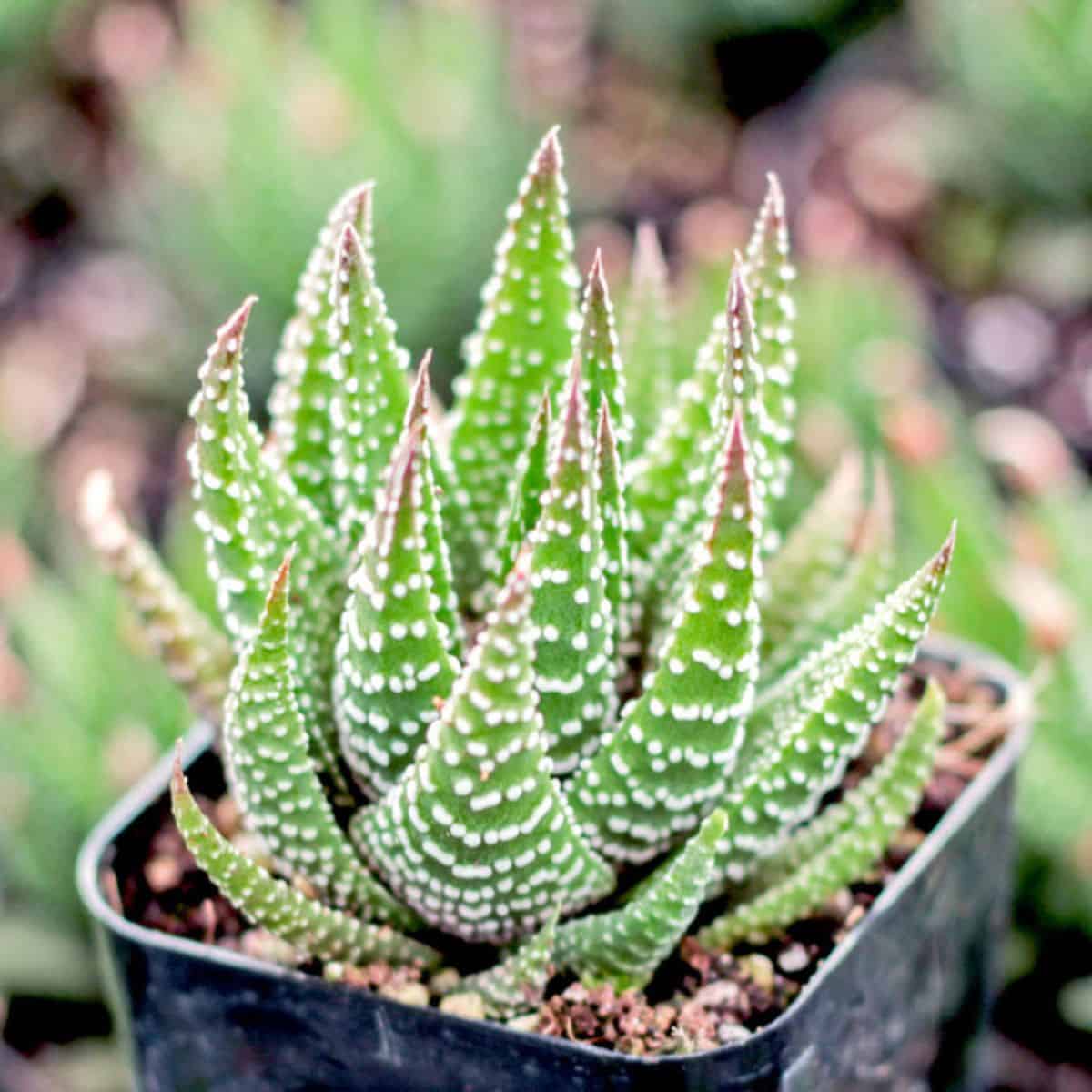
Buy it from:
| Maximum Height: | 6 Inches |
| Maximum Width: | 5 Inches |
| Watering Needs: | Once per week |
| Soil Needs: | Loamy well-draining soil |
| Light Needs: | Indirect sun, only 4 hours of bright sunlight or burns will occur |
| Hardiness Zone(s): | Zones 9 - 11 |
| Bloom Color: | White with green veins |
| Bloom Type: | Six-petaled with a tube base |
| Leaf Type: | Triangular with an extreme narrowing at the tip. |
| Growth Type: | One main mother with several pups that build a mound |
This species is often confused with Haworthia fasciata but the major difference is that H. attenuata has tubercles (the white bumpy parts) on both sides of the leaves. Despite the confusion, both species are easy to care for and form fun clumps of spiky, triangular leaves.
3. Blue Diamond
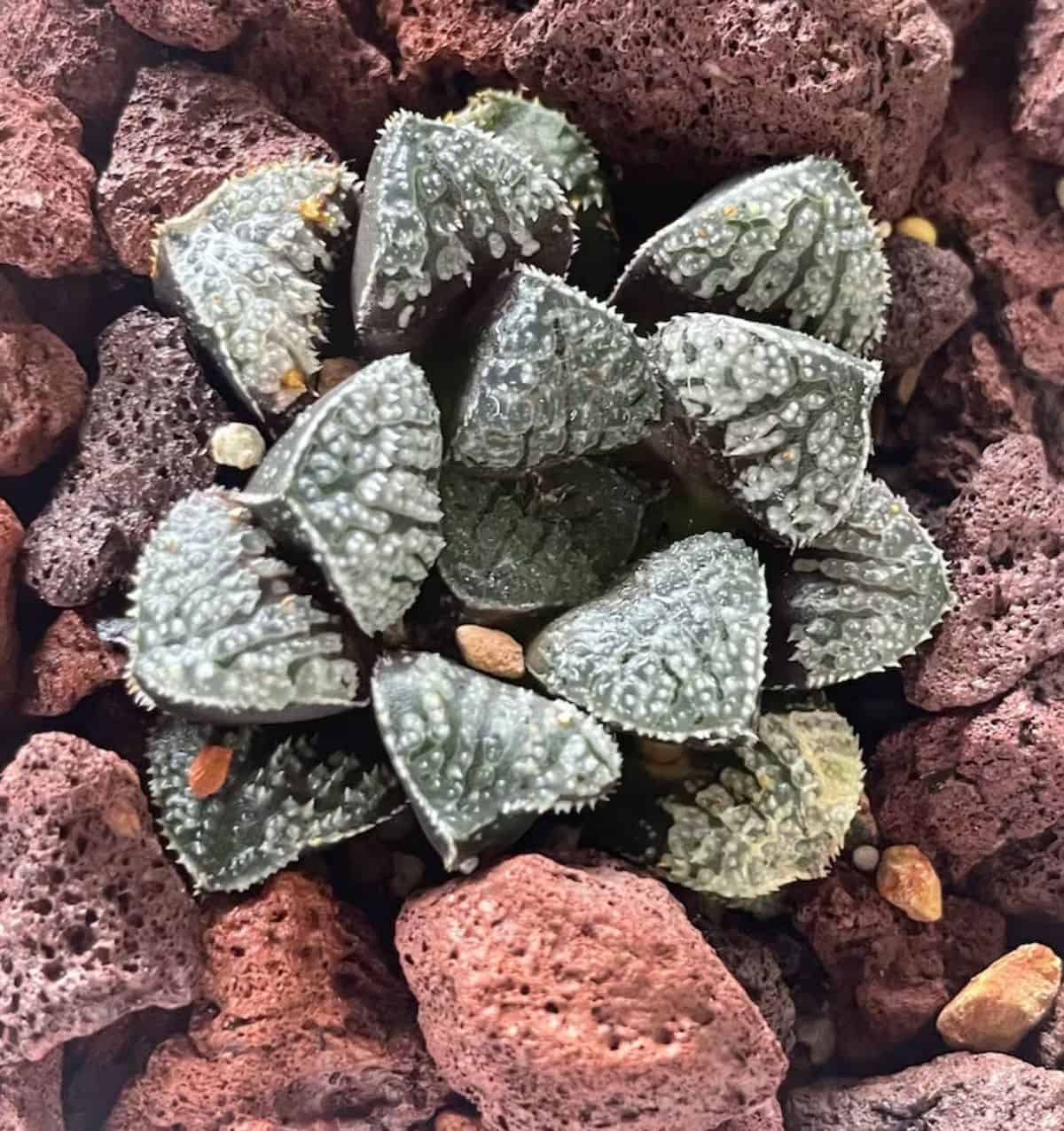
Buy it from:
| Maximum Height: | Under 4 Inches |
| Maximum Width: | Under 4 Inches |
| Watering Needs: | Once per week |
| Soil Needs: | Loamy well-draining soil |
| Light Needs: | Indirect sun, only 4 hours of bright sunlight or burns will occur |
| Hardiness Zone(s): | Zone 9 - 11 |
| Bloom Color: | White |
| Bloom Type: | Six-petaled with a tube base |
| Leaf Type: | Wide triangle with spined tubercules |
| Growth Type: | Singular rosette with pups that can form a mound if not separated |
Blue diamond is one of the rarities in the haworthia world. The variegation along the windows is covered with crystalline spikes, which hides the generally clear appearance of haworthia windows. The color of this species varies from light blue-green on younger leaves to a deep sapphire blue, which makes this species unmistakable.
4. Zebra Haworthia
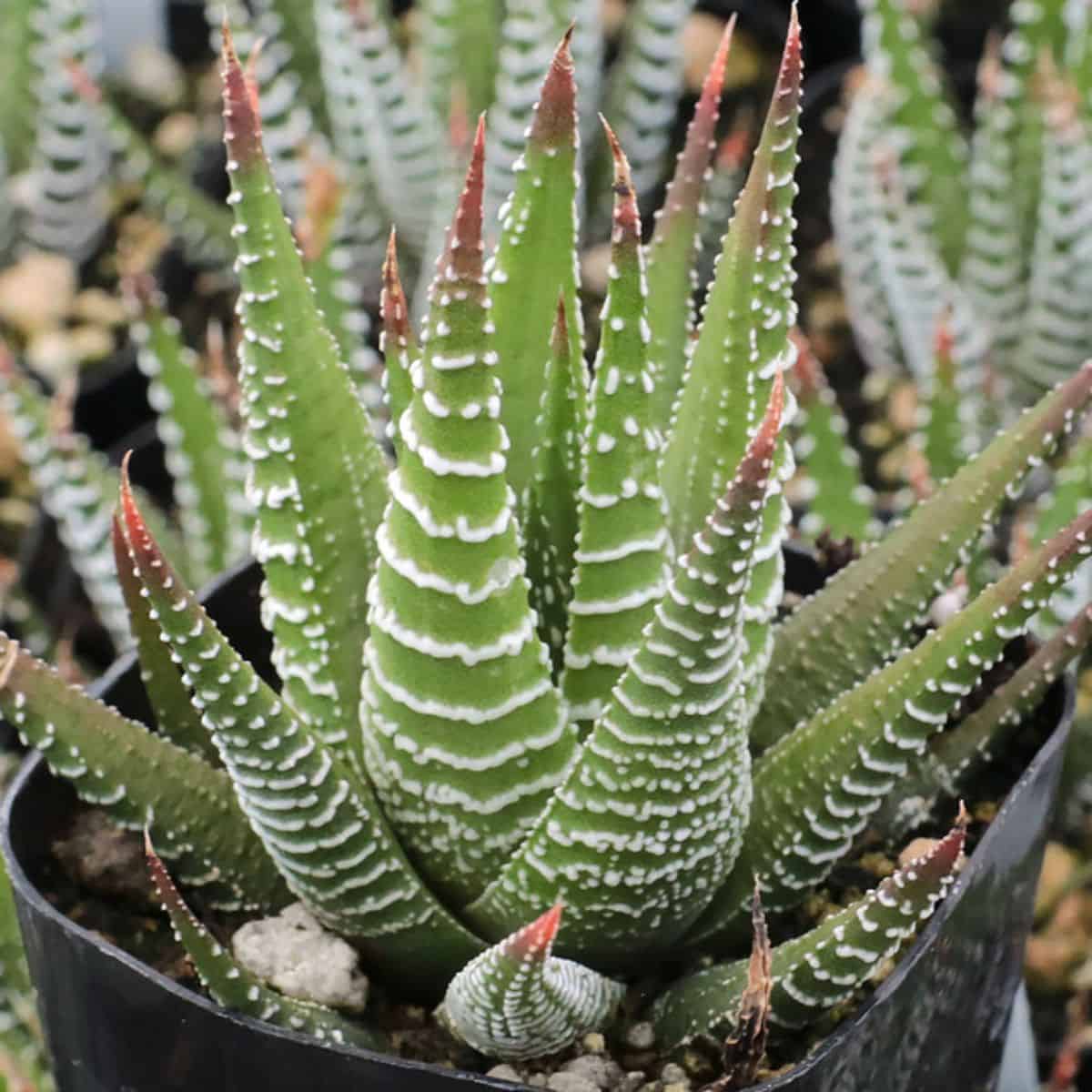
Buy it from:
| Maximum Height: | Up to 3 inches |
| Maximum Width: | Up to 6 inches |
| Watering Needs: | Once per week |
| Soil Needs: | Loamy well-draining soil |
| Light Needs: | Indirect sun, only 4 hours of bright sunlight or burns will occur |
| Hardiness Zone(s): | Zone 10 and up |
| Bloom Color: | White |
| Bloom Type: | Six-petaled with tube base |
| Leaf Type: | Triangular with white bumps along the outside of the leaf |
| Growth Type: | Will clump together if pups are not separated |
Haworthia fasciata is the species mentioned earlier that often is confused with the Zebra Plant. Zebra Haworthia differs because the horizontal tubercules are often packed tightly along the outside of the leaves, and the inner part of the leaves is almost always silky smooth.
5. Haworthia cuspidata
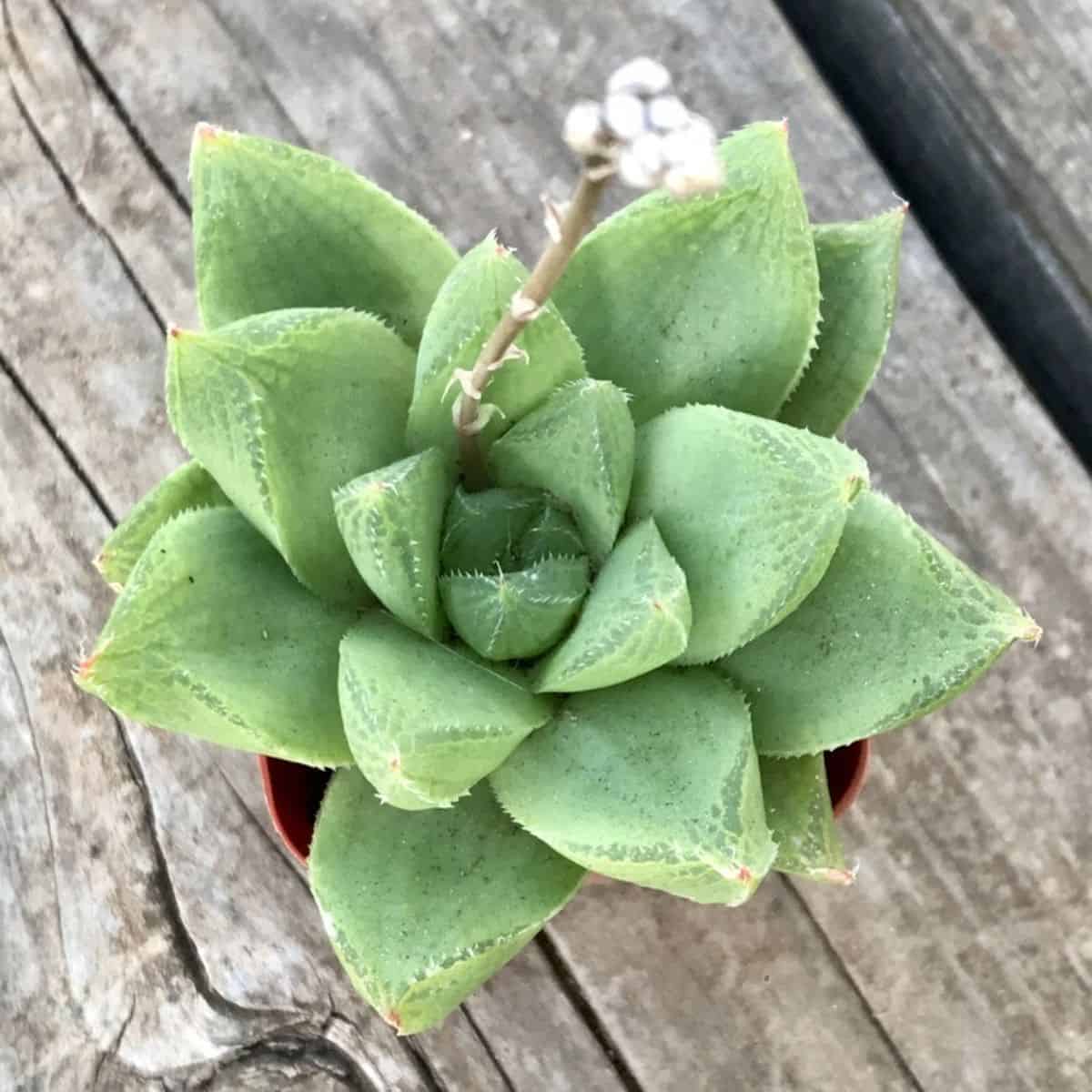
Buy it from:
| Maximum Height: | Up to 4 inches |
| Maximum Width: | Up to 4 inches |
| Watering Needs: | Once per week |
| Soil Needs: | Loamy well-draining soil |
| Light Needs: | Indirect sun, only 4 hours of bright sunlight or burns will occur |
| Hardiness Zone(s): | Zone 9 and up |
| Bloom Color: | White with brown-green veins (8-inch flowering stalk) |
| Bloom Type: | Six-petaled with tube base |
| Leaf Type: | Oval at the based and pointed at the tip |
| Growth Type: | Pups often nestle between the leaves of the mother |
Cuspidata refers to the pointed tips of the leaves, which is what gives this species the common name of Starry Haworthia. The texture of the leaves appears more leathery, even on the windows. This gives the species a muted light green coloration that is rather attractive.
6. Pearl Plant
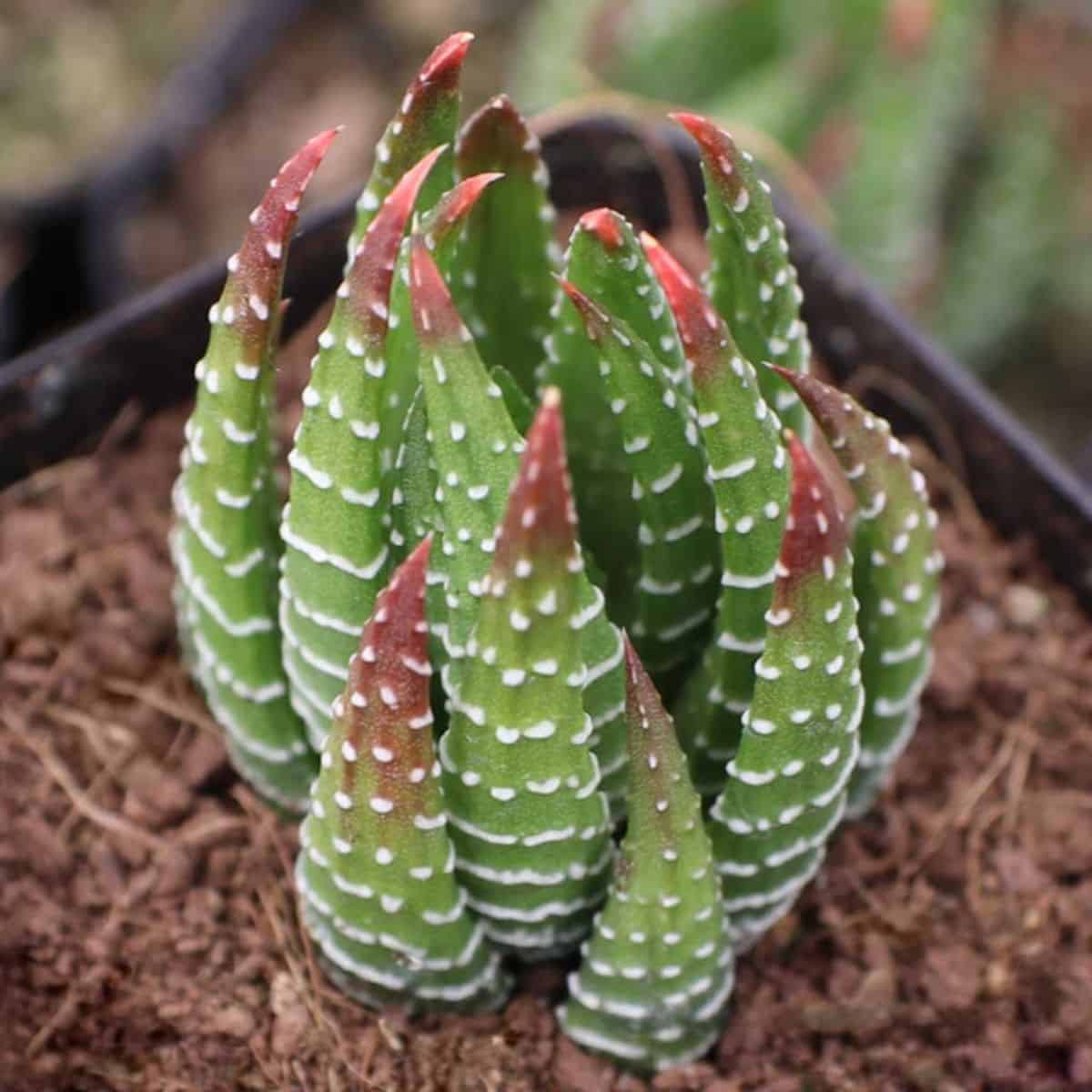
Buy it from:
| Maximum Height: | Up to 12 inches tall |
| Maximum Width: | Up to 6 inches wide |
| Watering Needs: | Once per week |
| Soil Needs: | Loamy well-draining soil |
| Light Needs: | Indirect sun, only 4 hours of bright sunlight or burns will occur |
| Hardiness Zone(s): | Zone 6 and up |
| Bloom Color: | Green to light brown |
| Bloom Type: | Six-petaled with tube base |
| Leaf Type: | Triangular with white tubercles on both sides of the leaves |
| Growth Type: | Slow growing, takes time to clump together |
Considered one of the largest species of haworthia, the Haworthia reinwardtii (not to be confused with H. cooperi) takes quite a while to reach its superior height of nearly a foot! What sets this species apart from H. attenuata and H. fasciata is that the tubercles form nearly perfect, white, circular spots along the inside and outside of the leaves.
7. Moon Shadow

Buy it from:
| Maximum Height: | Up to 3 inches |
| Maximum Width: | Up to 3 inches |
| Watering Needs: | Once per week |
| Soil Needs: | Loamy well-draining soil |
| Light Needs: | Indirect sun, only 4 hours of bright sunlight or burns will occur |
| Hardiness Zone(s): | Zone 9 and up |
| Bloom Color: | White |
| Bloom Type: | Six-petaled with tube base |
| Leaf Type: | Pyramidal leaves with minimal white variegation along the windows |
| Growth Type: | Flattened rosette |
Haworthia ‘Tsukigage’ is a hybrid from Japan (which is where you can find many beautiful hybrids!) between H. bayeri and H. comptoniana. The common name of Moon Shadow comes from how this species is a slightly darker green with beautiful white variegation along the windows. While not impressive in size, the deep-growing haworthia makes up for it in aesthetics.
8. Pink Mutica
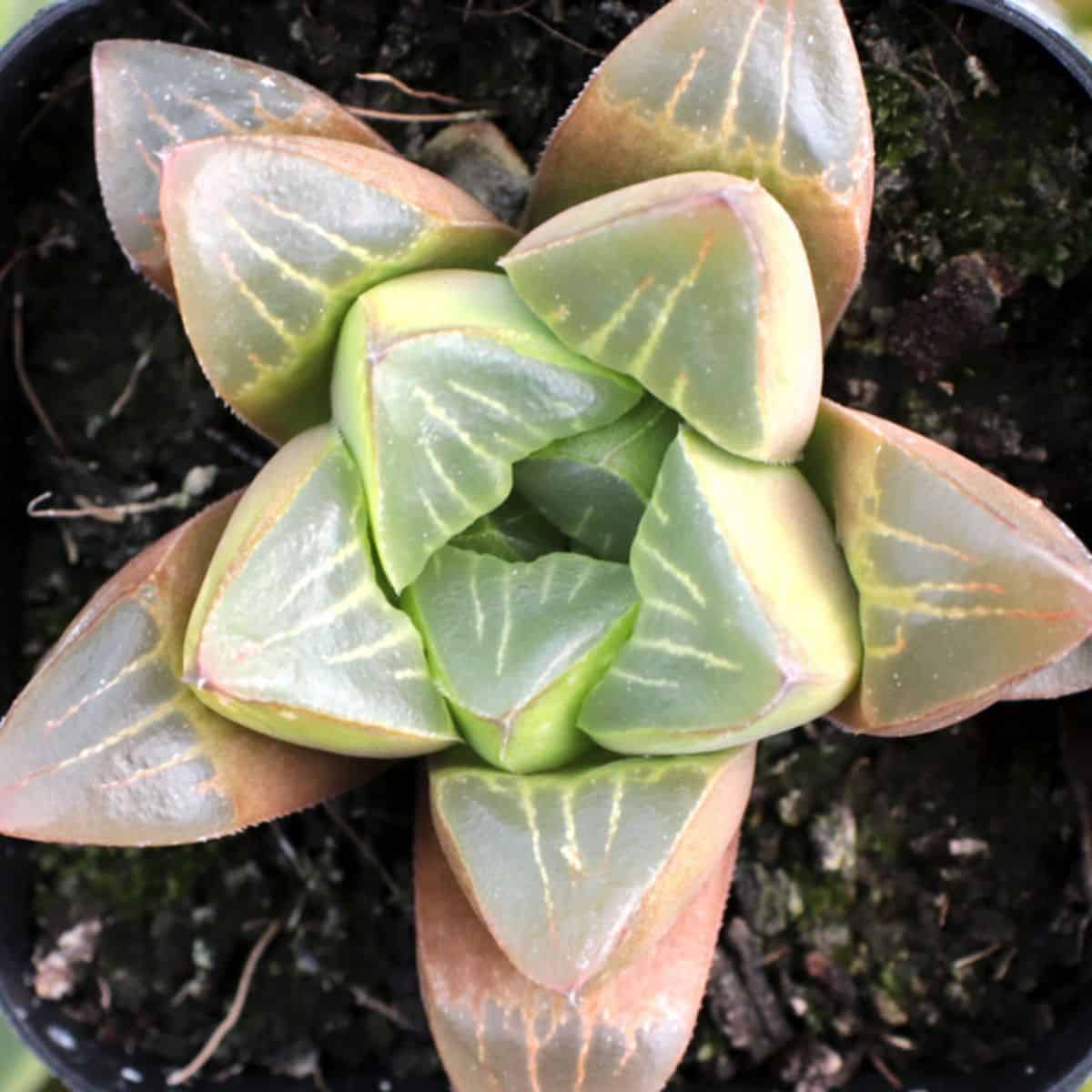
Buy it from:
| Maximum Height: | Up to 3 inches |
| Maximum Width: | Up to 3 inches |
| Watering Needs: | Once per week |
| Soil Needs: | Loamy well-draining soil |
| Light Needs: | Indirect sun, only 4 hours of bright sunlight or burns will occur |
| Hardiness Zone(s): | Zone 10 |
| Bloom Color: | Green-White with purple veins |
| Bloom Type: | Six-petaled with tube base |
| Leaf Type: | Pyramidal with spiny variegation on windows |
| Growth Type: | Small clusters |
Another rarity, the Pink Mutica, or Haworthia mutica, is a very unique species of haworthia. Not only does it commonly blush a peachy pink, it also is one of the few species that has flowers that are not pure white. Another characteristic that sets this species apart is the crystal-like structures that follow the variegation along the windows.
9. Haworthia cymbiformis
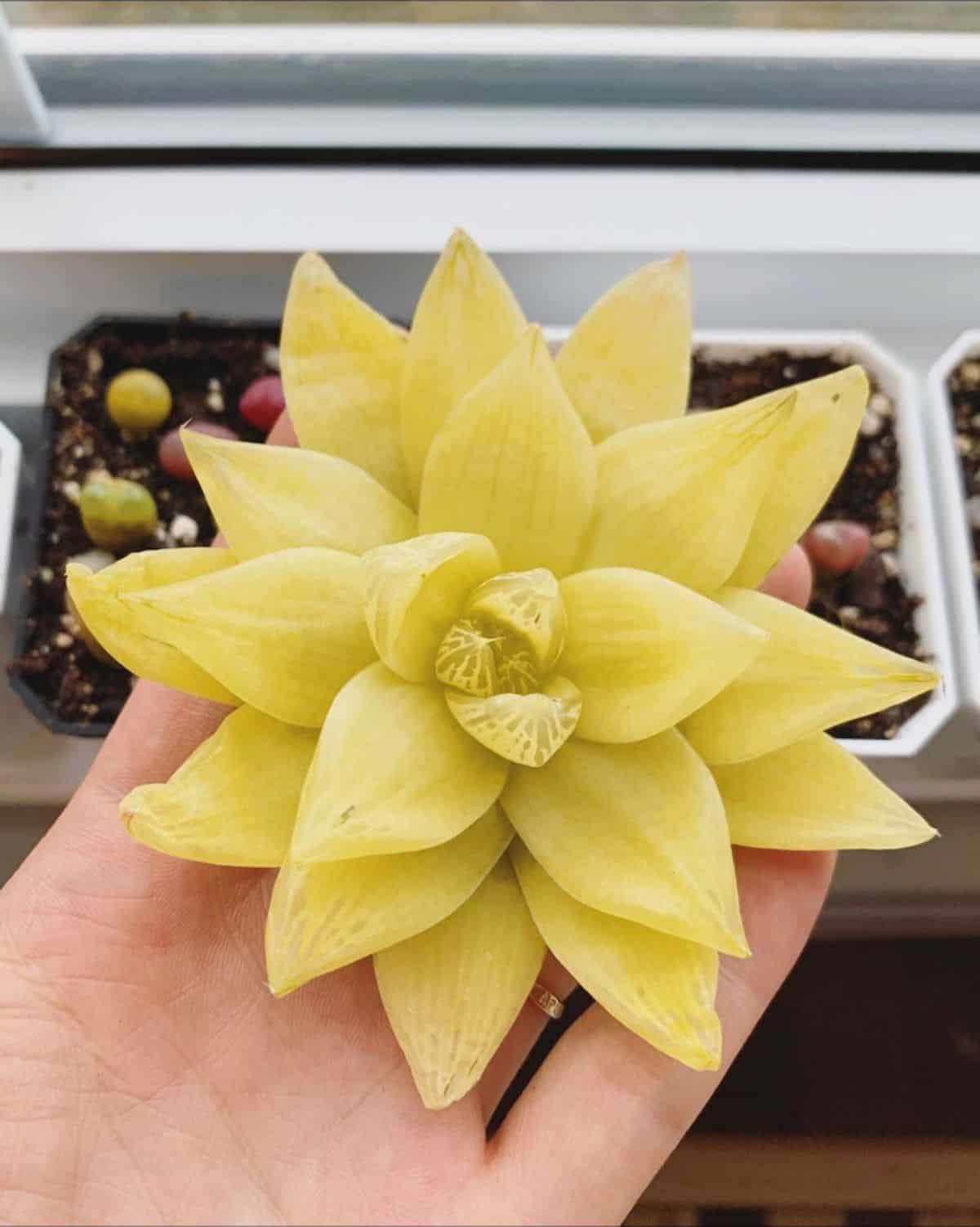
Buy it from:
| Maximum Height: | Up to 3 inches |
| Maximum Width: | Up to 4 inches |
| Watering Needs: | Once per week |
| Soil Needs: | Loamy well-draining soil |
| Light Needs: | Indirect sun, only 4 hours of bright sunlight or burns will occur |
| Hardiness Zone(s): | Zone 10 and up |
| Bloom Color: | White (rarely pale pink) with brown/green veins |
| Bloom Type: | Six-petaled with tube base (8-inch blooming stalk) |
| Leaf Type: | Triangular leaves that curve inwards to form a ‘boat’ |
| Growth Type: | Easily clusters |
Otherwise known as the Cathedral Window Haworthia, this special species has triangular leaves that are reminiscent of renaissance type stained glass windows. The naturally occurring windows at the tip of each leaf are variegated with slight bits of white and green, which adds to their unique nature.
10. Haworthia coarctata

Buy it from:
| Maximum Height: | Up to 8 inches |
| Maximum Width: | Up to 2 inches |
| Watering Needs: | Once per week |
| Soil Needs: | Loamy well-draining soil |
| Light Needs: | Indirect sun, only 4 hours of bright sunlight or burns will occur |
| Hardiness Zone(s): | Zone 10 and up |
| Bloom Color: | White |
| Bloom Type: | Six-petaled with tube base |
| Leaf Type: | Triangular with liner tubercles |
| Growth Type: | Compact Slow growing clump |
Haworthiopsis coarctata is an interesting species because of how it grows. Think about a far more compact H. attenuata, fasciata, or reinwardtii that grows along a stem instead of staying in a wide-open rosette. What also sets this species apart is that the tubercles aren’t all one shape. Some are horizontal, and some are more pearl-like. You never know what new variation you’ll get on new leaves!
11. Haworthia tortuosa, Variegated
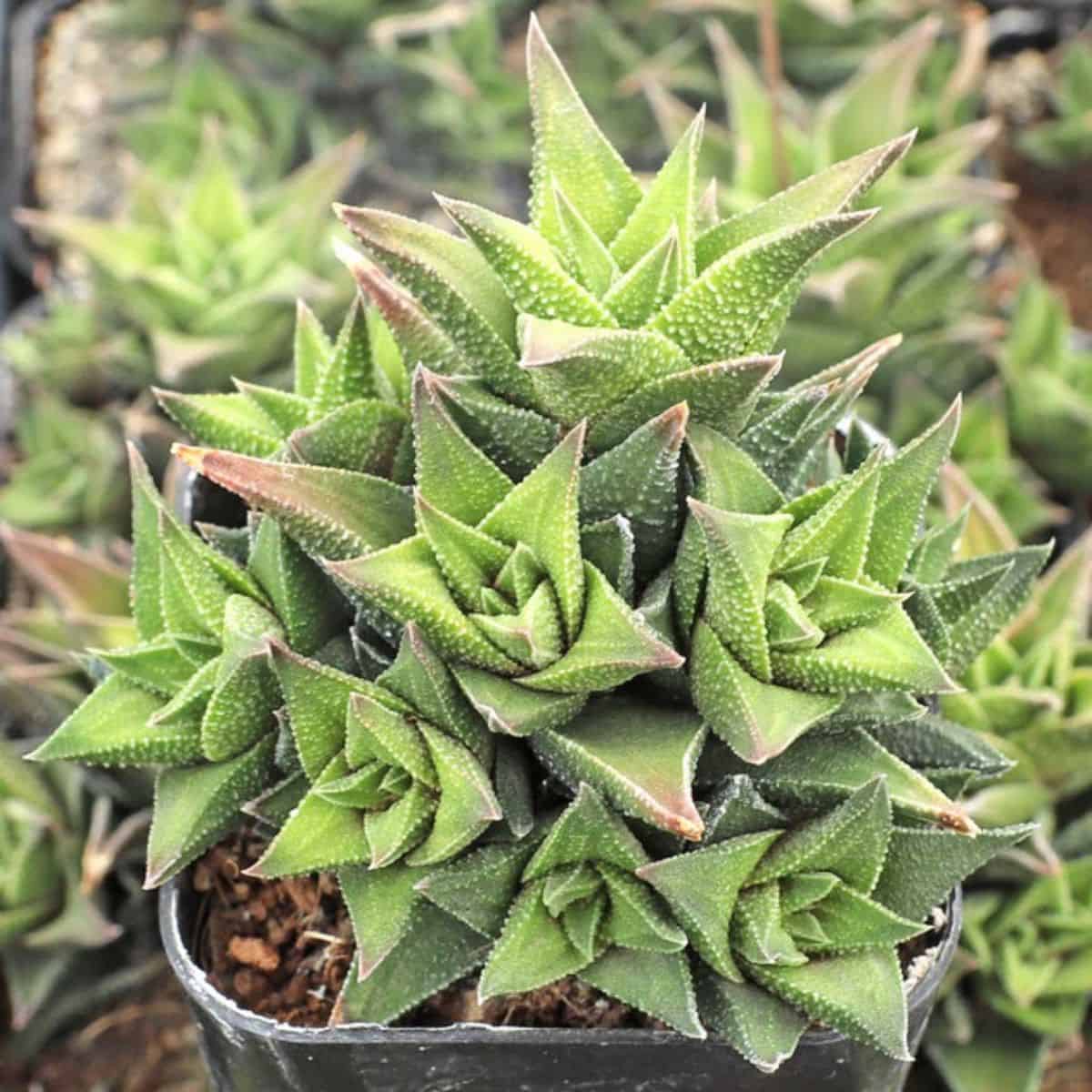
Buy it from:
| Maximum Height: | Up to 8 inches |
| Maximum Width: | Up to 3 inches |
| Watering Needs: | Once per week |
| Soil Needs: | Loamy well-draining soil |
| Light Needs: | Indirect sun, only 4 hours of bright sunlight or burns will occur |
| Hardiness Zone(s): | Zone 6 and up |
| Bloom Color: | White |
| Bloom Type: | Six-petaled with tube base |
| Leaf Type: | Small triangular leaves |
| Growth Type: | Grows upwards on a stem: leaves spiral around the stem. |
Similarly to H.coarctata, this species tends to grow a little more on the tall side while still maintaining an open rosette. The beauty comes in the light green to yellow variegation that is randomly dispersed along the leaves. Akin to Fairies Washboard, there are ridges along the inside and outside of the leaves.
12. Emerald Cloud*
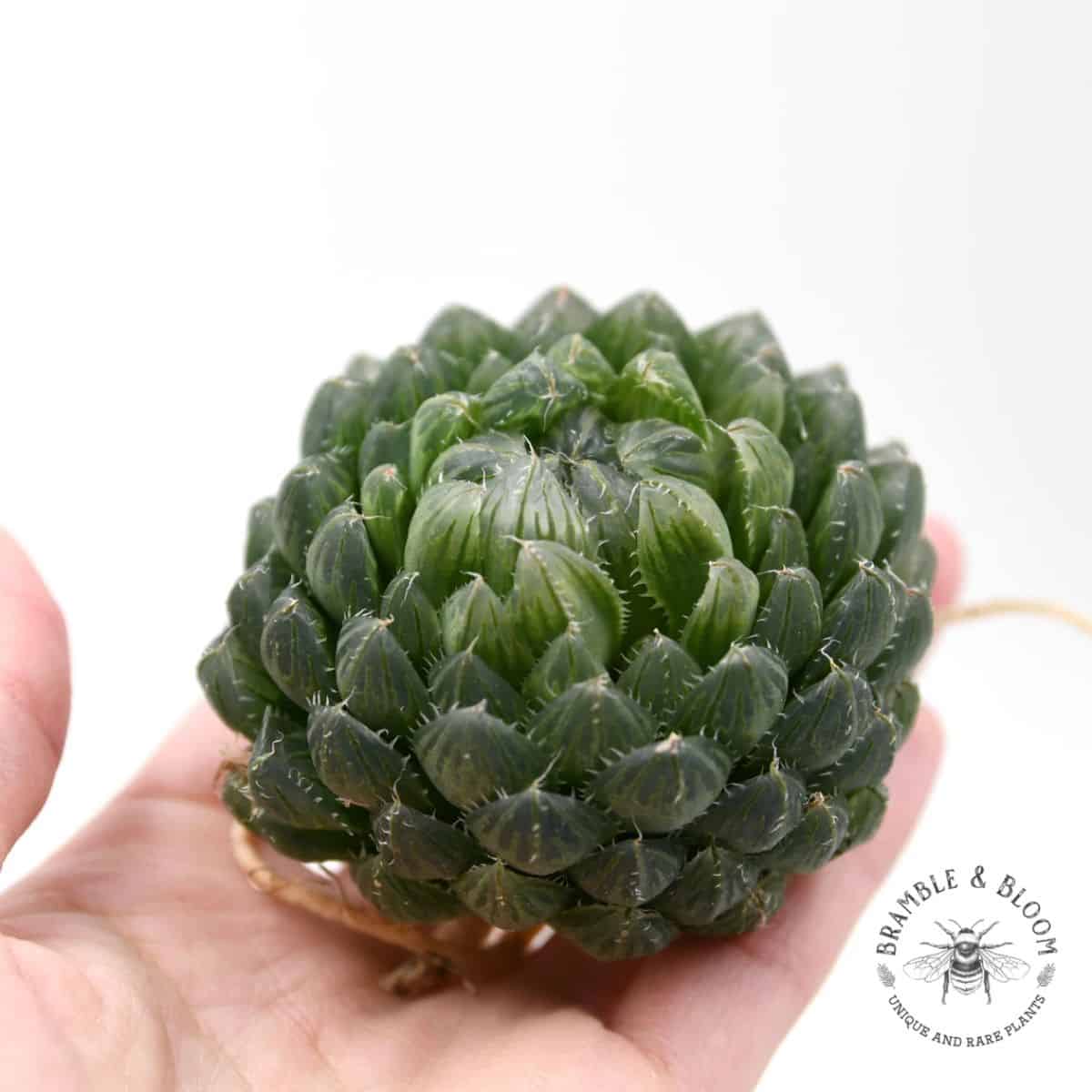
*Please note that the details in this chart are assumed based on general species specifications. Accurate information on this species is almost non-existent at this point in time.
Buy it from:
| Maximum Height: | Up to 3 inches |
| Maximum Width: | Up to 3 inches |
| Watering Needs: | Once per week |
| Soil Needs: | Loamy well-draining soil |
| Light Needs: | Indirect sun, only 4 hours of bright sunlight or burns will occur |
| Hardiness Zone(s): | Zone 8/9 and up |
| Bloom Color: | White |
| Bloom Type: | Six-petaled with tube base |
| Leaf Type: | Oval to triangular: the majority of the leaf consists of windows |
| Growth Type: | Clumping variety |
Also considered the jewel of the succulent world, Haworthia Emerald Cloud is a beautifully compact species with a hazy, cloud-like appearance. The base of the rounder leaves is a gorgeous emerald green that fades to tipped windows. When seen at just about any angle, this species will truly amaze with how it reflects and refracts light.
13. Fairies Washboard
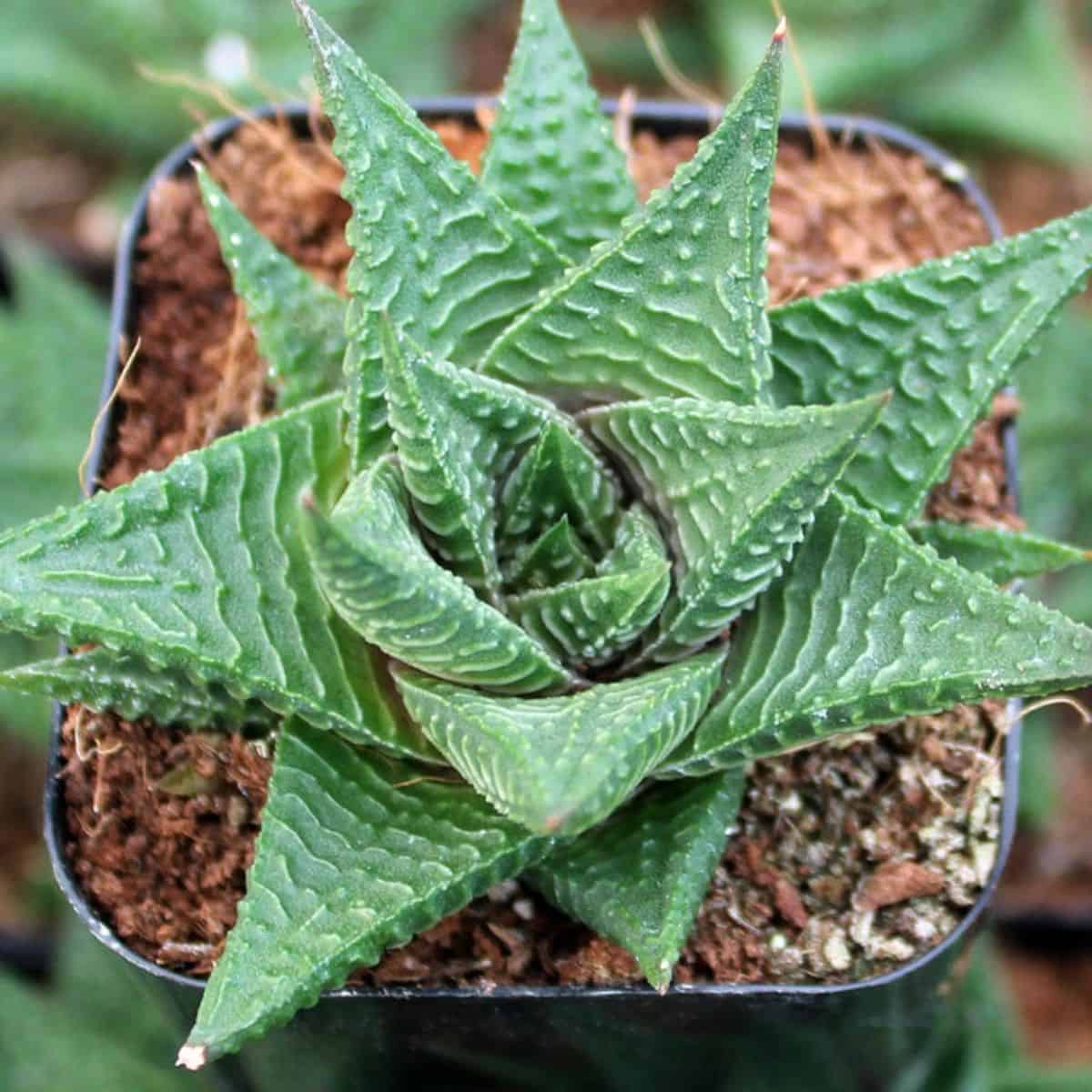
Buy it from:
| Maximum Height: | Up to 5 inches |
| Maximum Width: | Up to 4 inches |
| Watering Needs: | Once per week |
| Soil Needs: | Loamy well-draining soil |
| Light Needs: | Filtered sun |
| Hardiness Zone(s): | Zone 10 and up |
| Bloom Color: | White |
| Bloom Type: | Six-petaled with tube base |
| Leaf Type: | Triangular with raised horizontal ridges |
| Growth Type: | Clumps around the base |
Haworthia limifolia is one of the more texturally pleasant species. The triangular leaves curl up slightly at the edges and have prominent ridges that look akin to tubercules. However, the major difference is that these ridges aren’t white, and they are evenly spaced along the leaves.
14. Haworthia limifolia, Variegated
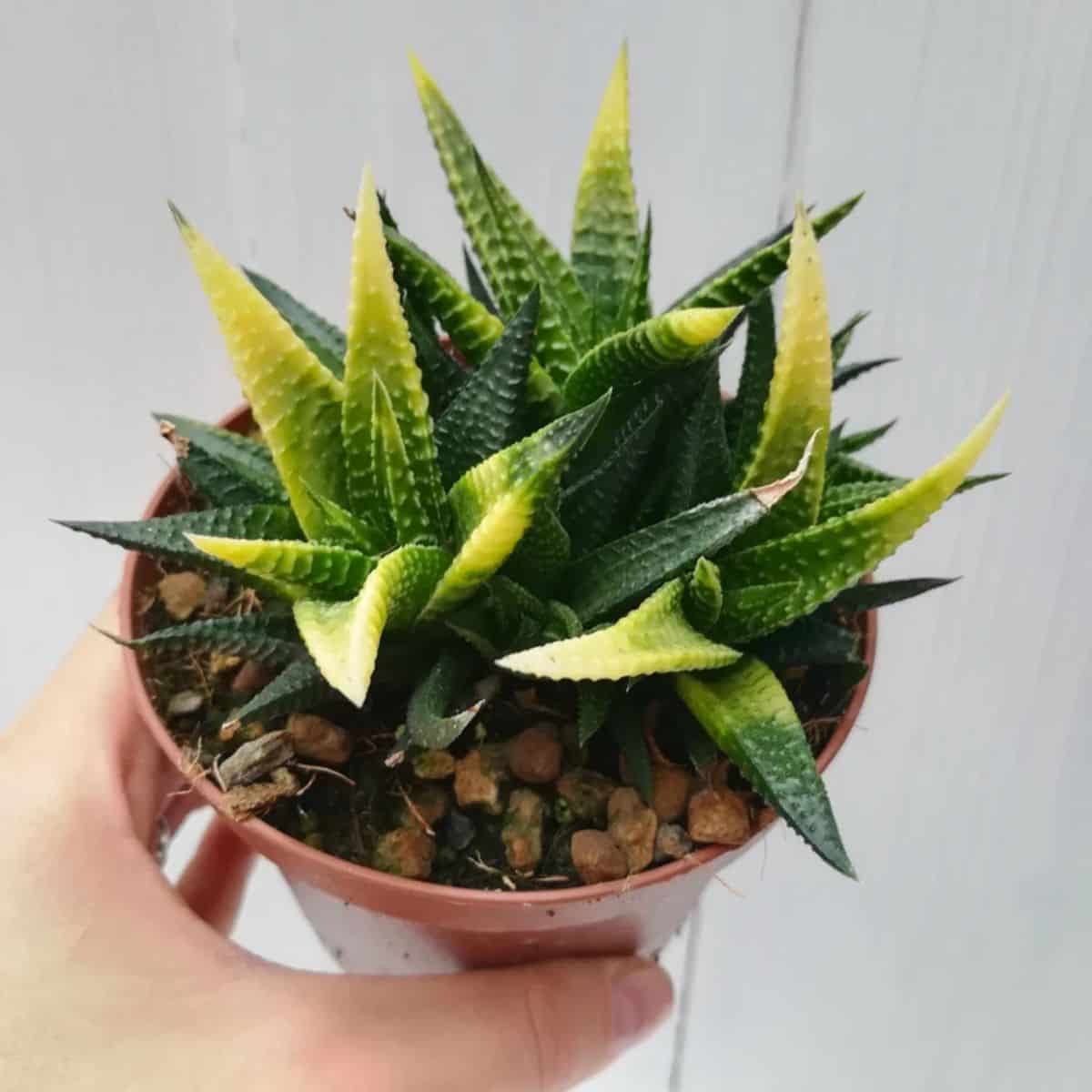
Buy it from:
| Maximum Height: | Up to 4 inches |
| Maximum Width: | Up to 4 inches |
| Watering Needs: | Once per week |
| Soil Needs: | Loamy well-draining soil |
| Light Needs: | Indirect sun, only 4 hours of bright sunlight or burns will occur |
| Hardiness Zone(s): | Zone 10 and up |
| Bloom Color: | White |
| Bloom Type: | Six-petaled with tube base |
| Leaf Type: | Triangular with more oval bases |
| Growth Type: | Easily clumping |
The major difference between the two types of Haworthia limifolia (variegated and not) is the shape of the leaves and their color. At times, and if you are lucky, you can find a Fairies Washboard that is mostly yellow! The variegation does happen randomly, and the leaves tend to take on a more swirling appearance around the center of the rosette.
15. Haworthia Obtusa ssp.
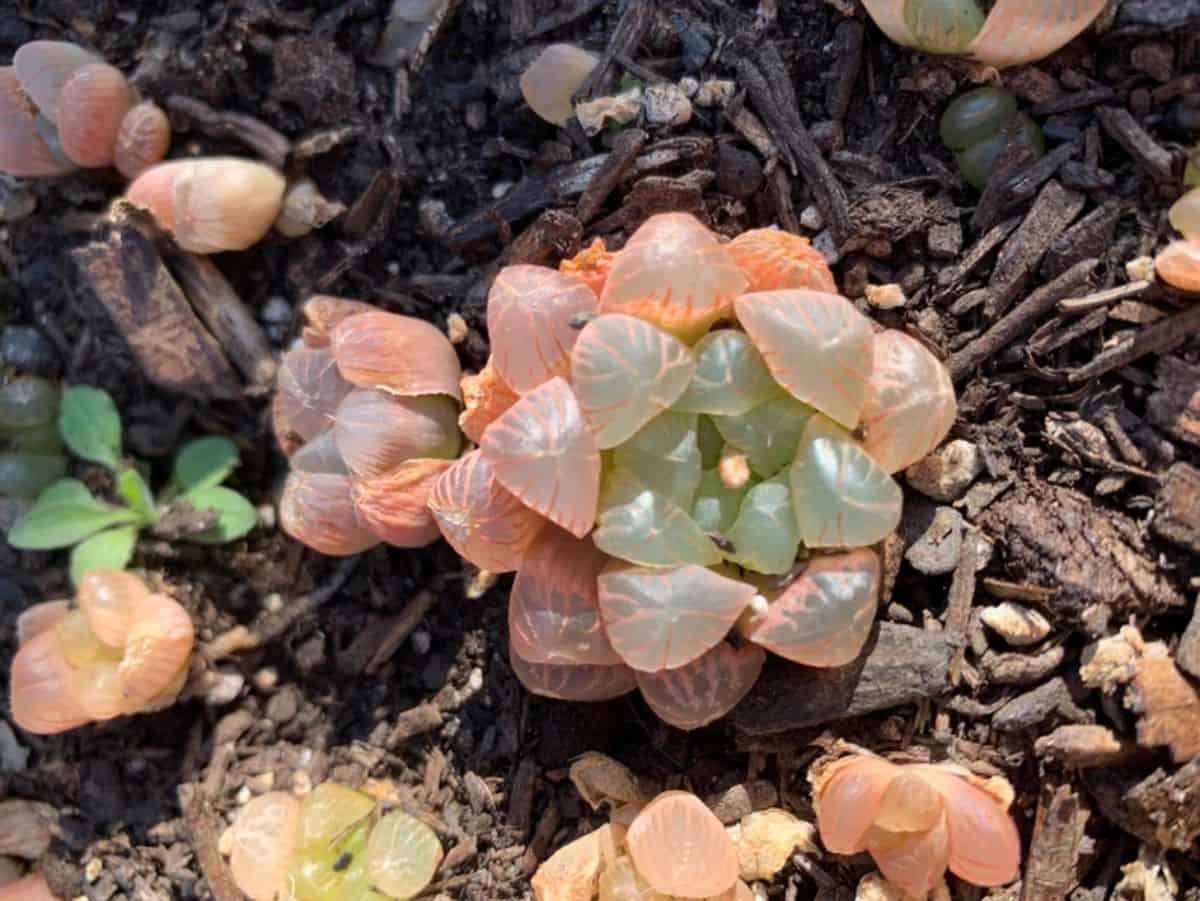
Buy it from:
| Maximum Height: | Up to 4 inches |
| Maximum Width: | Up to 4 inches |
| Watering Needs: | Once per week |
| Soil Needs: | Loamy well-draining soil |
| Light Needs: | Indirect sun, only 4 hours of bright sunlight or burns will occur |
| Hardiness Zone(s): | Zone 10 and up |
| Bloom Color: | White green with |
| Bloom Type: | Six-petaled with tube base |
| Leaf Type: | Entirely rounded, including the tips of the leaves |
| Growth Type: | Ground cover type that settles deeper into the soil |
There are many hybrids of Haworthia obtusa. The non-hybridized species is a beautiful light green, but you will find more of the hybrids available as they are often more desired. From blushing Barbie pinks, light yellows, and variegated mixes, this deep settling rosette is one of the easiest to hybridize and collect.
16. Love Heart*
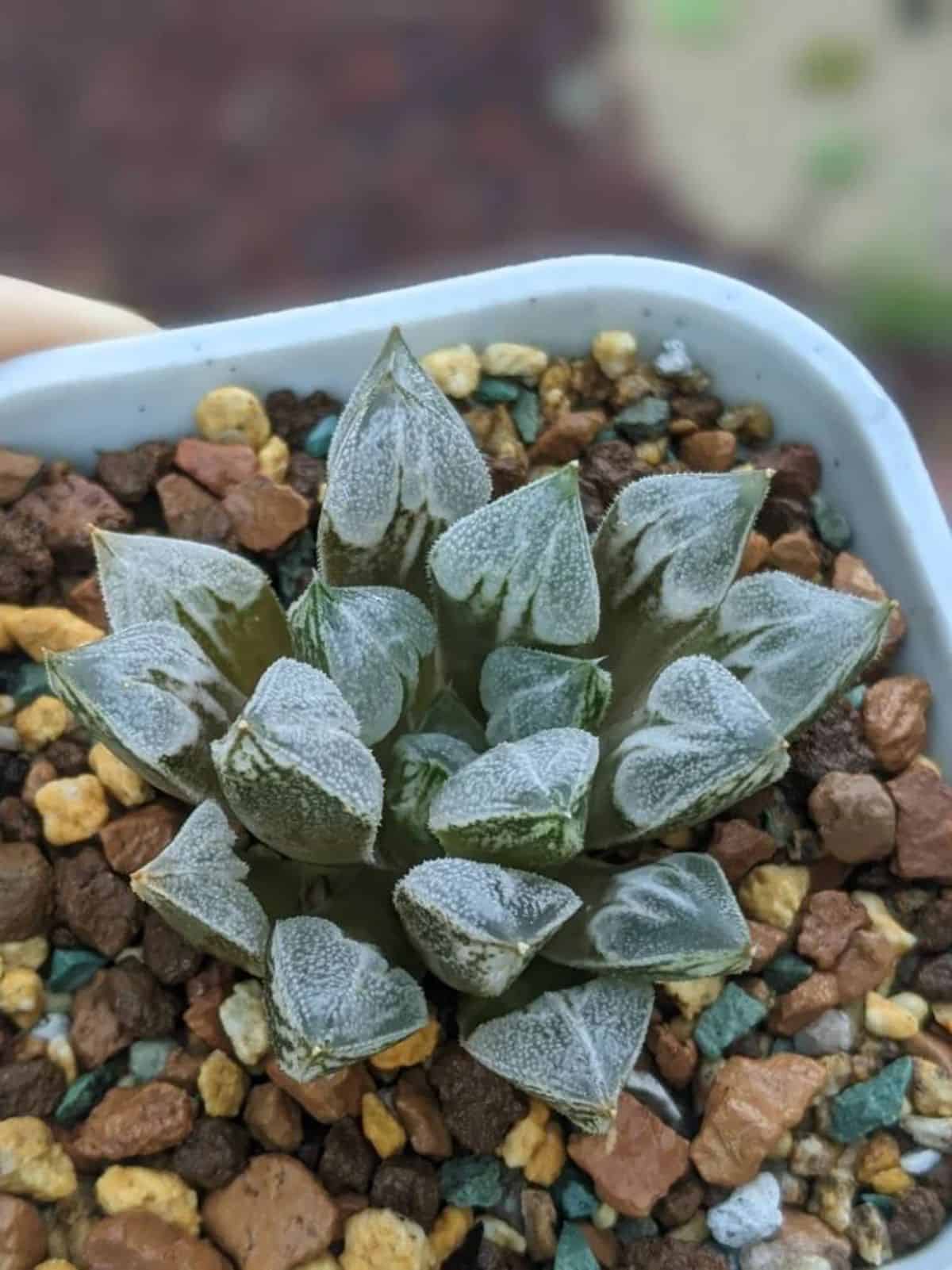
*Due to the rarity of this species, accurate information is difficult to find. The details below are estimated based on species averages.
Buy it from:
| Maximum Height: | Up to 1.5 inches |
| Maximum Width: | Up to 3.5 inches |
| Watering Needs: | Once per week |
| Soil Needs: | Loamy well-draining soil |
| Light Needs: | Indirect sun, best placed on a windowsill |
| Hardiness Zone(s): | Zone 10 and up |
| Bloom Color: | White |
| Bloom Type: | Six-petaled with tube base |
| Leaf Type: | Flattened at the top and pyramidal |
| Growth Type: | May cluster |
With a very flat rosette and astonishing leaves, this rare species of haworthia is a hard one to find. Etsy does have some available, but most have to be bought from South Korea or the U.K. and shipped around the world. Most of the time, the species will stay close to the ground as it does take them some time to grow to their full height. The perfectly heart-shaped tips of the leaves, with their powdery appearance, make it easily one of the most coveted species of haworthia.
17. Black Beauty
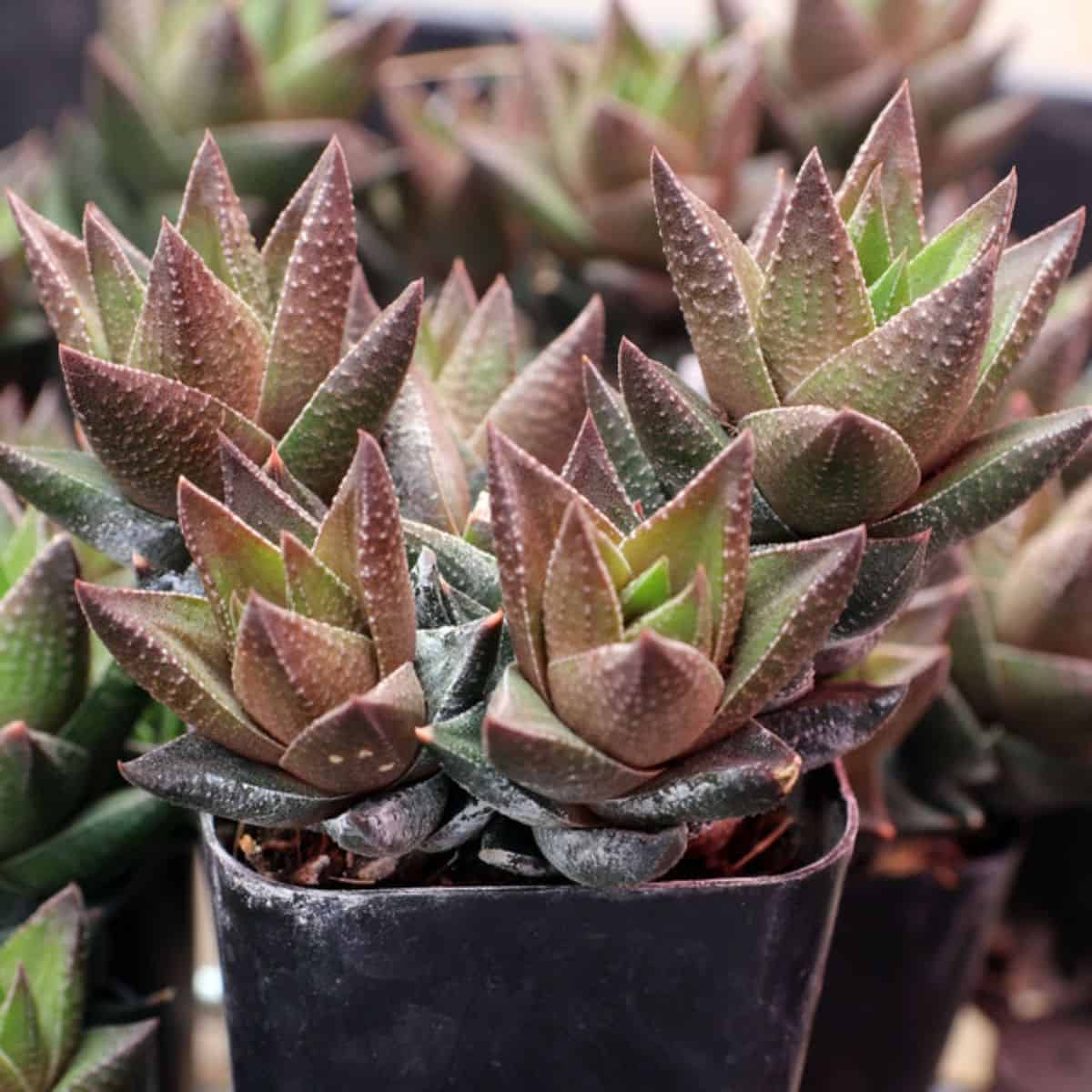
Buy it from:
| Maximum Height: | Up to 8 inches |
| Maximum Width: | Potentially up to four inches |
| Watering Needs: | Once per week |
| Soil Needs: | Loamy well-draining soil |
| Light Needs: | Indirect sunlight or low indoor sun |
| Hardiness Zone(s): | Zone 10 and up |
| Bloom Color: | White |
| Bloom Type: | Six-petaled with tube base |
| Leaf Type: | Very thick and pyramidal with some tubercles along the margins |
| Growth Type: | Wide open rosette that can clump |
When not dug deep into the ground, this species can get up to eight inches in height. The reason for its name is the deep purple, almost black, coloration that can occur when this species is exposed to more sunlight. My favorite element of this species is just how thick the leaves are. Unlike other flat rosette-type haworthia’s, this species takes on a more robust and thick appearance.
18. Haworthia truncata var. maughanii
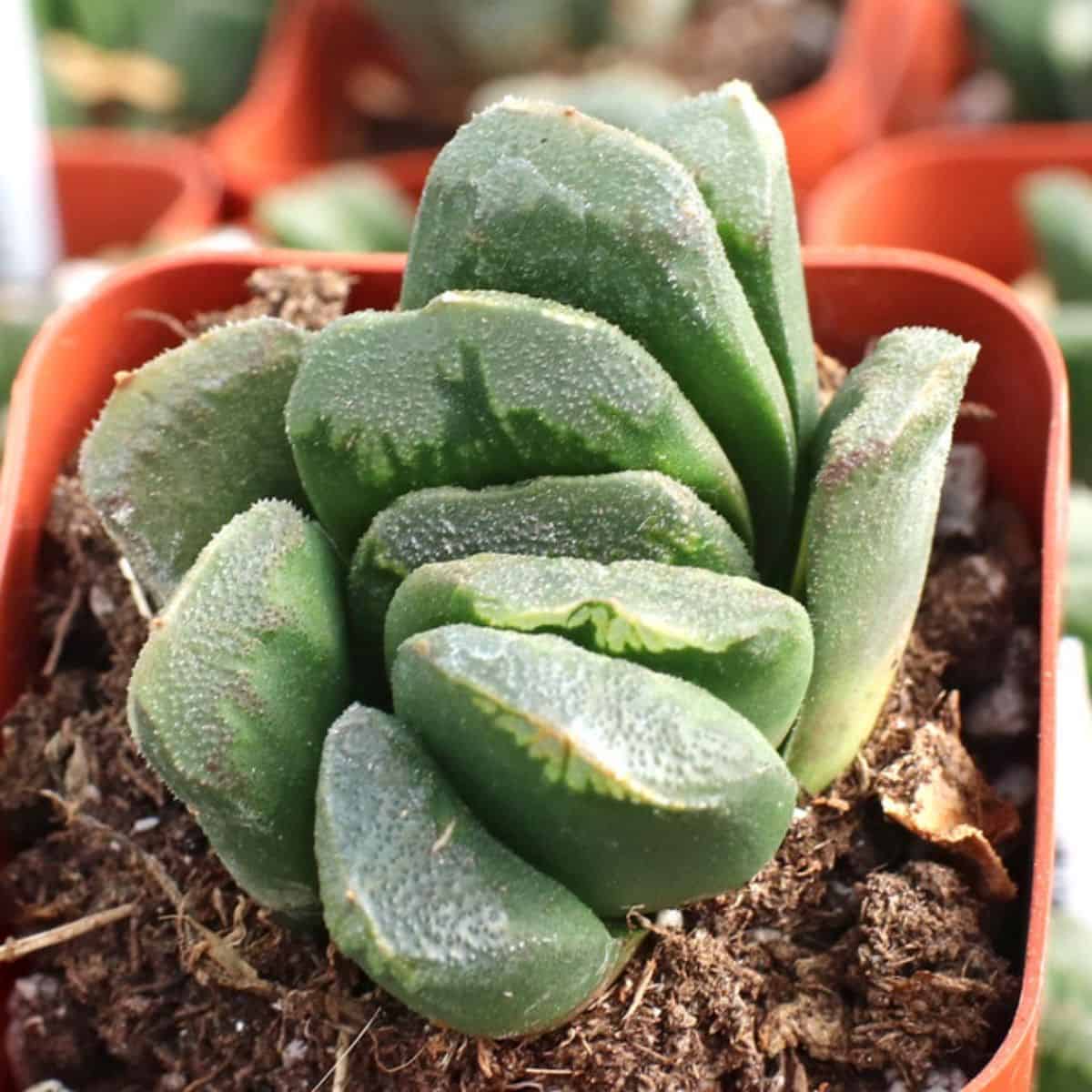
Buy it from:
| Leaf Maximum Height: | Up to 1 inch |
| Leaf Maximum Width: | Up to .6 inches |
| Watering Needs: | Once per week |
| Soil Needs: | Loamy well-draining soil |
| Light Needs: | Indirect sun, only 4 hours of bright sunlight or burns will occur |
| Hardiness Zone(s): | Zone 10 and up |
| Bloom Color: | White |
| Bloom Type: | Six-petaled with tube base |
| Leaf Type: | Tubular with flat windows at the top |
| Growth Type: | Continually spreading leaves (this makes it difficult to determine how wide the species can spread) |
Any of the H. truncata species are interesting to collect! They often look like elephant teeth and spread out continually. This species is very different from the others because, instead of growing in a more linear pattern, maughnii tends to grow in a circular pattern. Not only that, but the leaves are extremely thick! They grow upward in columns with circular windows that have some dark green variegation along the tops.
19. Red Stone
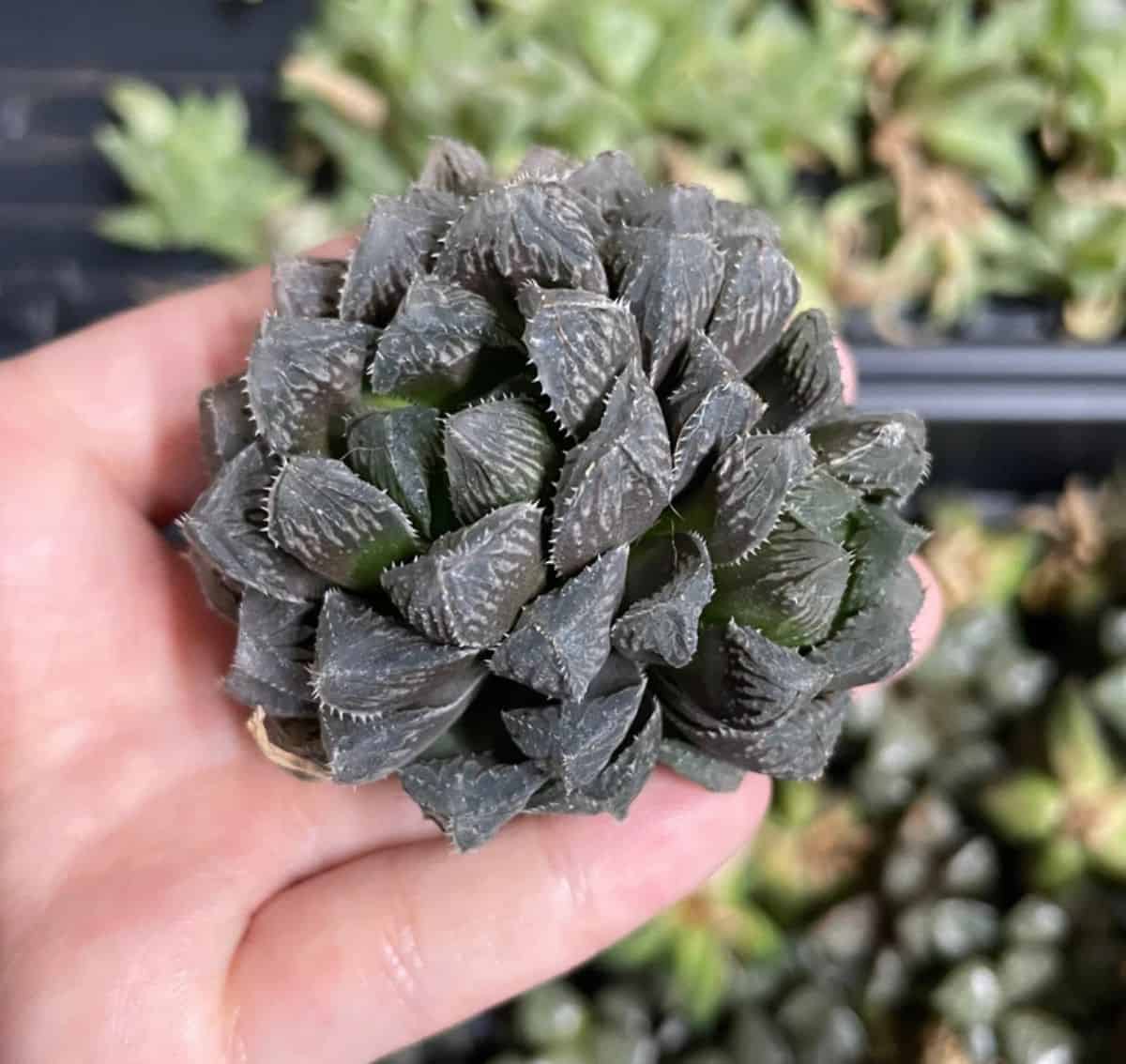
Buy it from:
| Maximum Height: | Up to 10 inches |
| Maximum Width: | Up to 10 inches |
| Watering Needs: | Once per week |
| Soil Needs: | Loamy well-draining soil |
| Light Needs: | Full filtered sun |
| Hardiness Zone(s): | Zone 9 and up |
| Bloom Color: | Pinkish white |
| Bloom Type: | Six-petaled with tube base |
| Leaf Type: | Pyramidal with flat tops that have windows |
| Growth Type: | Slow growing and will clump |
Red stone is interesting because the coloration isn’t exactly red. Rather, it tends to take on a more deep purple-black with rusty red variegation along the leaves. This species, like many haworthia, are slow grower, so it will take time for this puffball-like species to reach its full size. Like other species, you can find small white teeth along the margins of the leaves.
20. Haworthia cooperi var. venusta
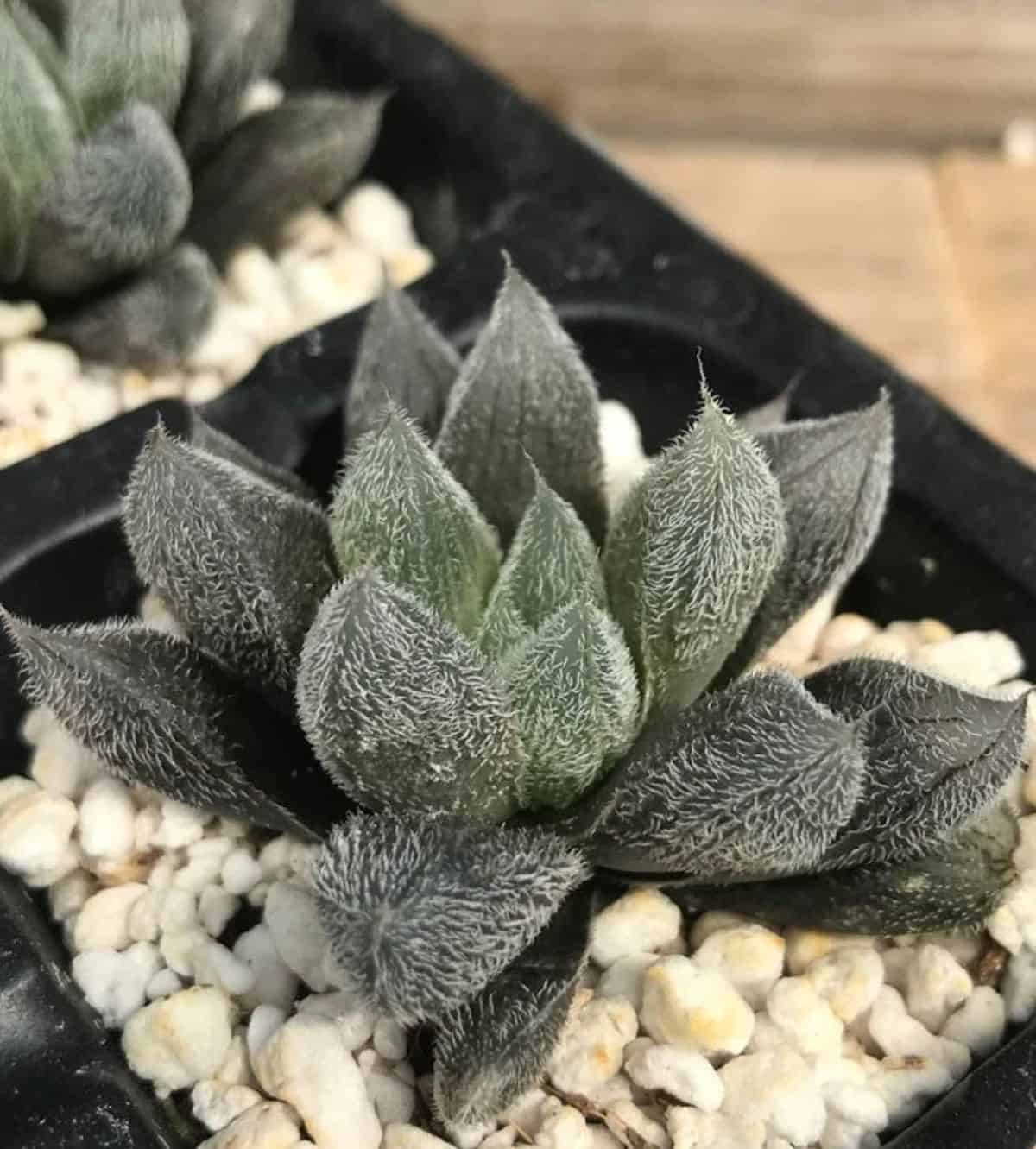
Buy it from:
| Maximum Height: | Up to 10 inches |
| Maximum Width: | Up to 10 inches |
| Watering Needs: | Once per week |
| Soil Needs: | Loamy well-draining soil |
| Light Needs: | Full filtered sun |
| Hardiness Zone(s): | Zone 9 and up |
| Bloom Color: | Pinkish white |
| Bloom Type: | Six-petaled with tube base |
| Leaf Type: | Pyramidal with pointed tips and covered in small, short cilia |
| Growth Type: | Slow growing and will clump |
This species has to be one of the cutest just because of how fuzzy it is! It is very similar, window-wise, to cymbiformis and it does have some variegation along the windows. The cilia that cover every part of the leaves are what give this species its fuzzy and cuddly appearance.
21. Haworthia tessellata
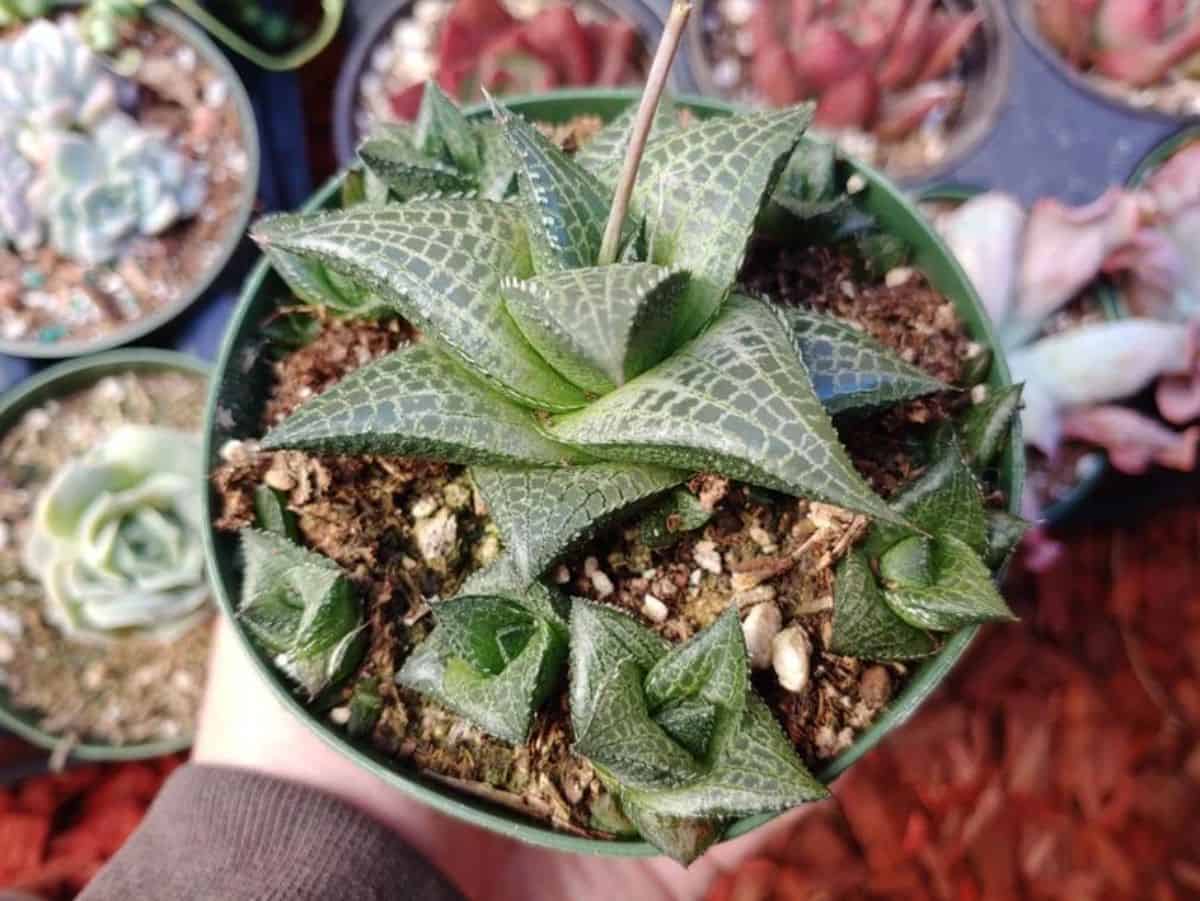
Buy it from:
| Maximum Height: | Up to 6 inches |
| Maximum Width: | Up to 4 inches |
| Watering Needs: | Once per week |
| Soil Needs: | Loamy well-draining soil |
| Light Needs: | Indirect sun, only 4 hours of bright sunlight or burns will occur |
| Hardiness Zone(s): | Zone 9 and up |
| Bloom Color: | White with green ribs |
| Bloom Type: | Six-petaled with tube base |
| Leaf Type: | Multicolor: Broad and triangular akin to Zebra haworthia, however they have a strong recurve and white teeth |
| Growth Type: | Can clump together |
Out of all of the locations where haworthia will grow, H. tessellata grows in many locations but is the only haworthia that will grow in Namibia! If you take a Haworthia cymbiformis and cross it with Haworthia attenuata, then that is what tessellata looks like. The leaves are more solid green on the underside, and the tops of the leaves are gorgeous variegated windows that extend the entire length of the triangular leaves.
22. Mordor
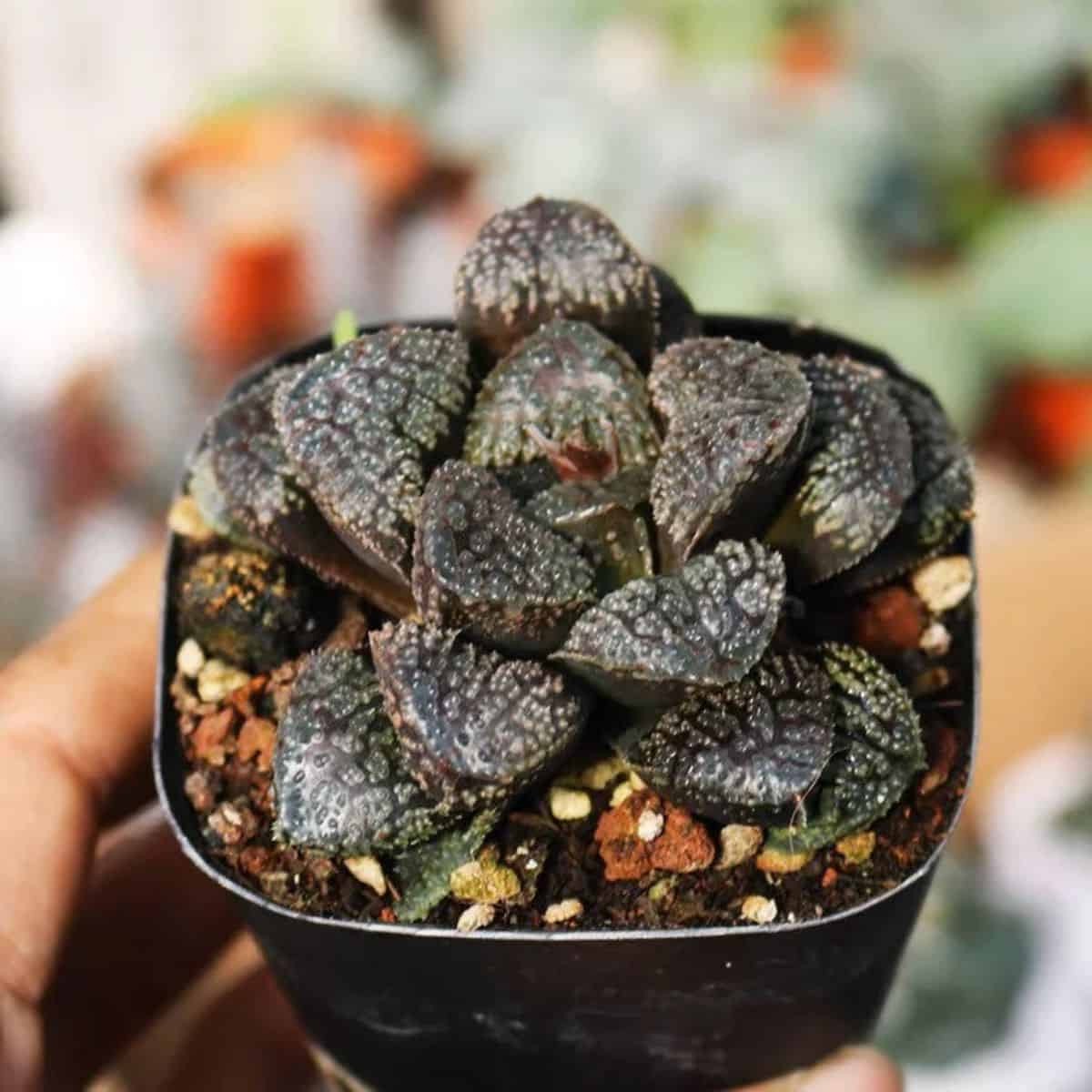
Buy it from:
| Maximum Height: | Approximately 2-3 inches |
| Maximum Width: | Approximately 2-3 inches |
| Watering Needs: | Once per week |
| Soil Needs: | Loamy well-draining soil |
| Light Needs: | Indirect sun, only 4 hours of bright sunlight or burns will occur |
| Hardiness Zone(s): | Zone 10 and up |
| Bloom Color: | White with brown veins |
| Bloom Type: | Six-petaled with tube base |
| Leaf Type: | Very thick leaves with an oval shape, toothed margins, and flattened shape |
| Growth Type: | Solitary rosette |
Yet another infamous Japanese hybrid, this species is a potential cross between Haworthia springbokvlakensis and Haworthia wimii (try saying that five times fast). Named after the dark lands ruled by Sauron from J.R.R. Tolkien’s world of Middle Earth, this species holds true to its dark origins. Covered with crystalline structures that resemble mountain peaks, you can bet Haworthia Mordor is on my must-have list!
23. Iron Ball
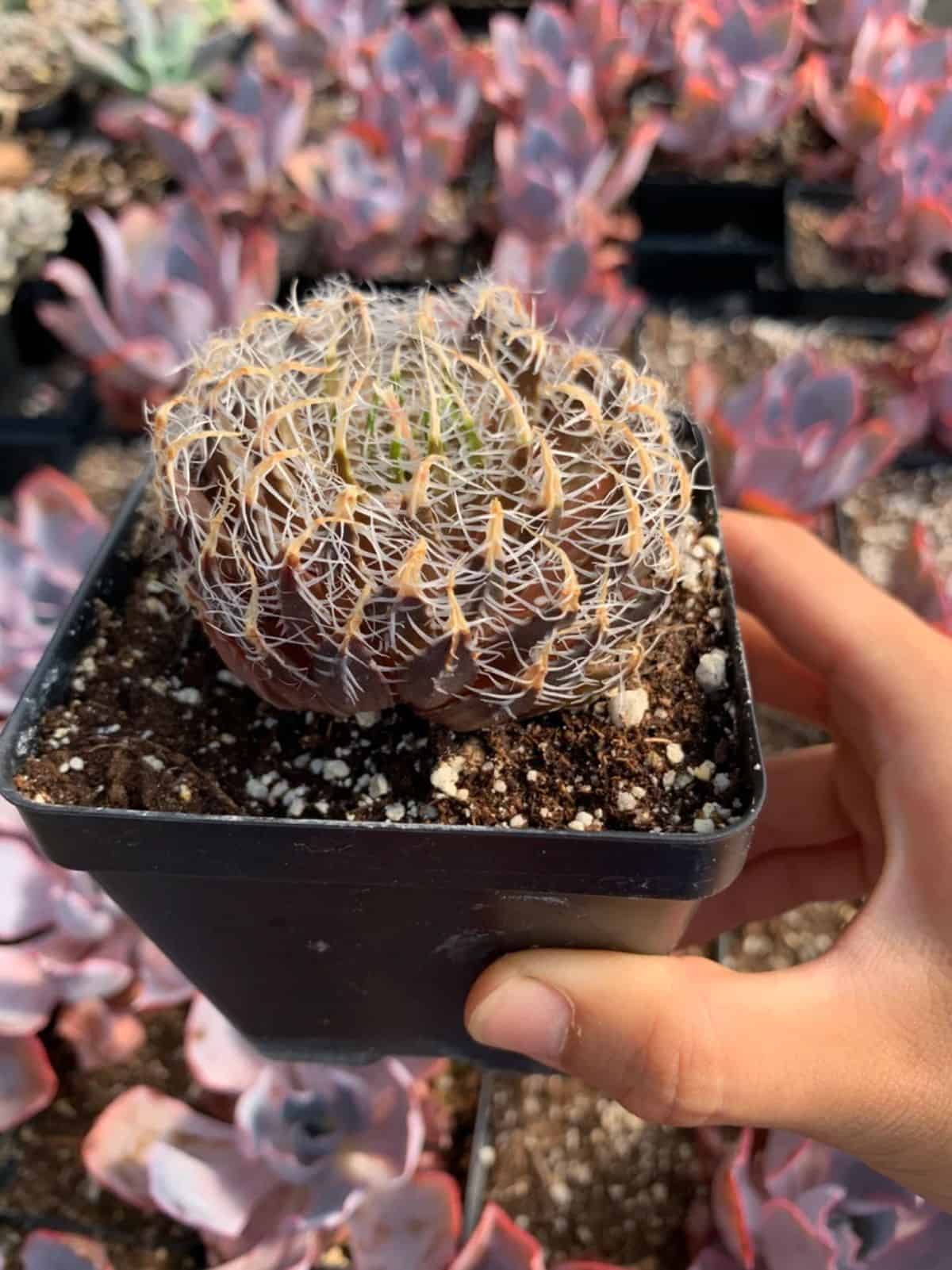
Buy it from:
| Maximum Height: | Approximately 2-3 inches |
| Maximum Width: | Approximately 2-3 inches |
| Watering Needs: | Once per week |
| Soil Needs: | Loamy well-draining soil |
| Light Needs: | Indirect sun, only 4 hours of bright sunlight or burns will occur |
| Hardiness Zone(s): | Zone 10 and up |
| Bloom Color: | white |
| Bloom Type: | Six-petaled with tube base |
| Leaf Type: | Triangular with long cilia |
| Growth Type: | Singular rosette |
Of course, I had to save the best for last! This species of haworthia takes so many of the characteristics of all of the species in the list and mashes them into one species. The leaves are triangular with spiky orange tips. Some of the leaves can have a few tubercles, but their most prominent feature is the thick cilia or teeth that are along the margins of each leaf.

